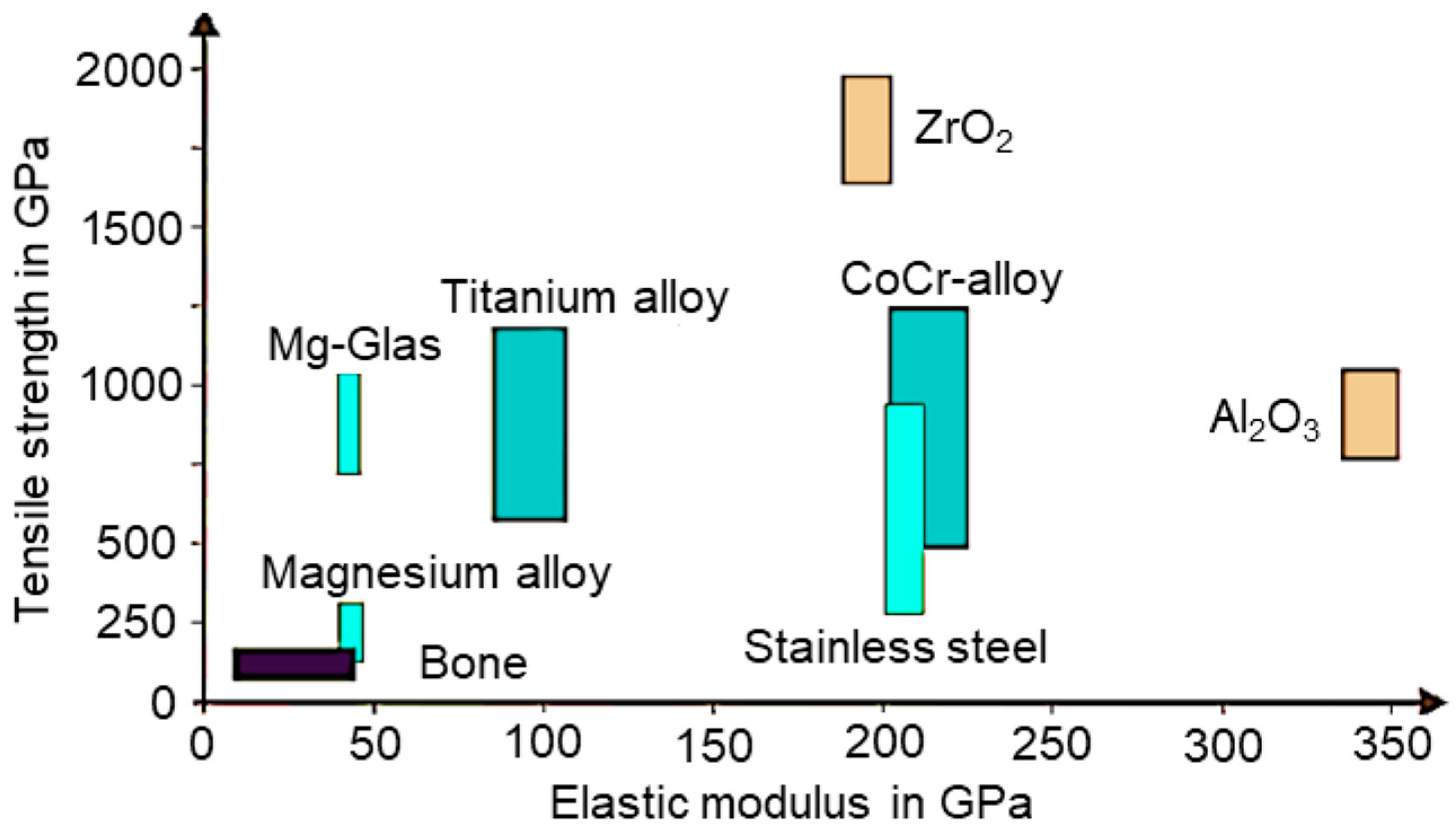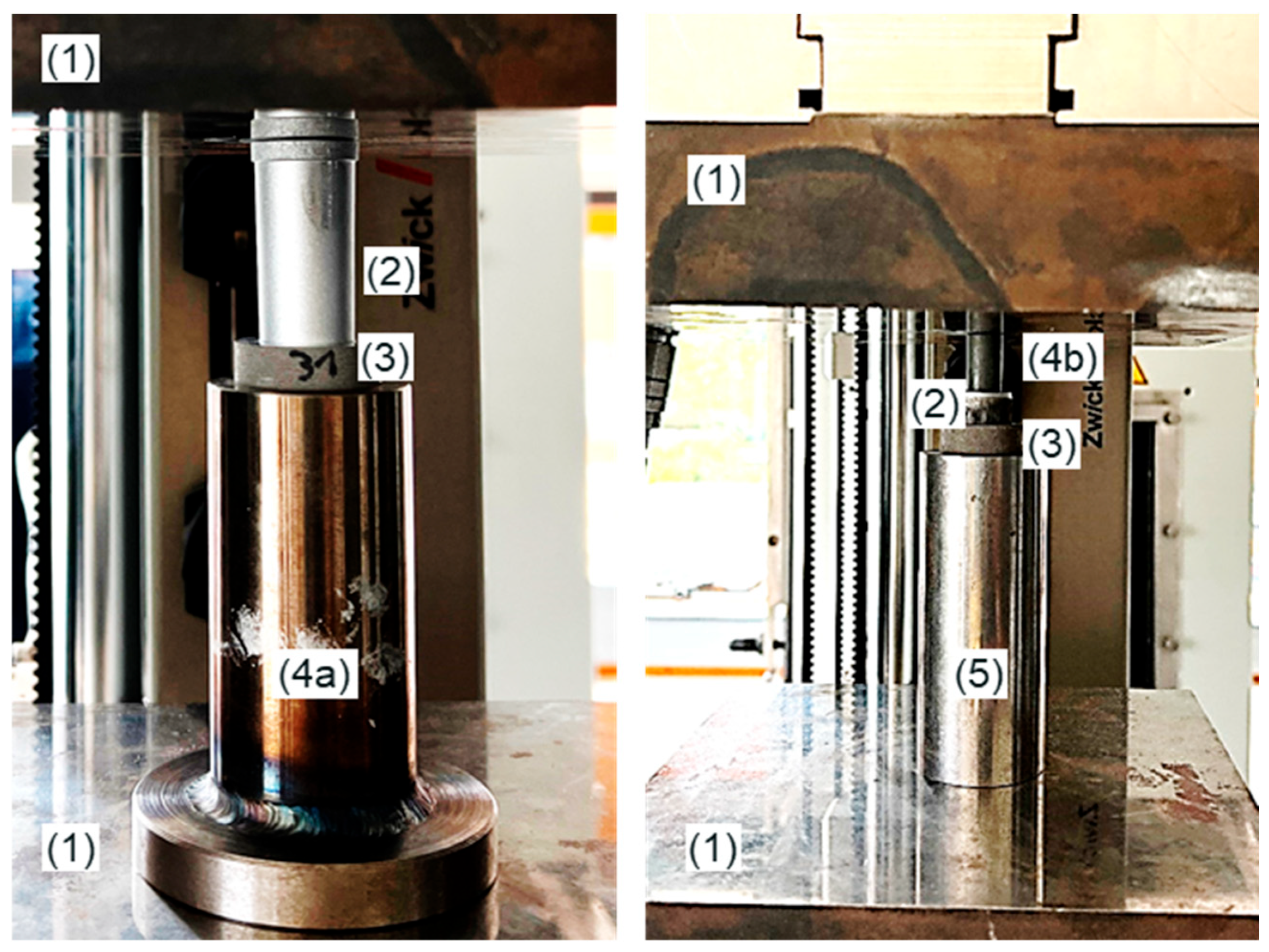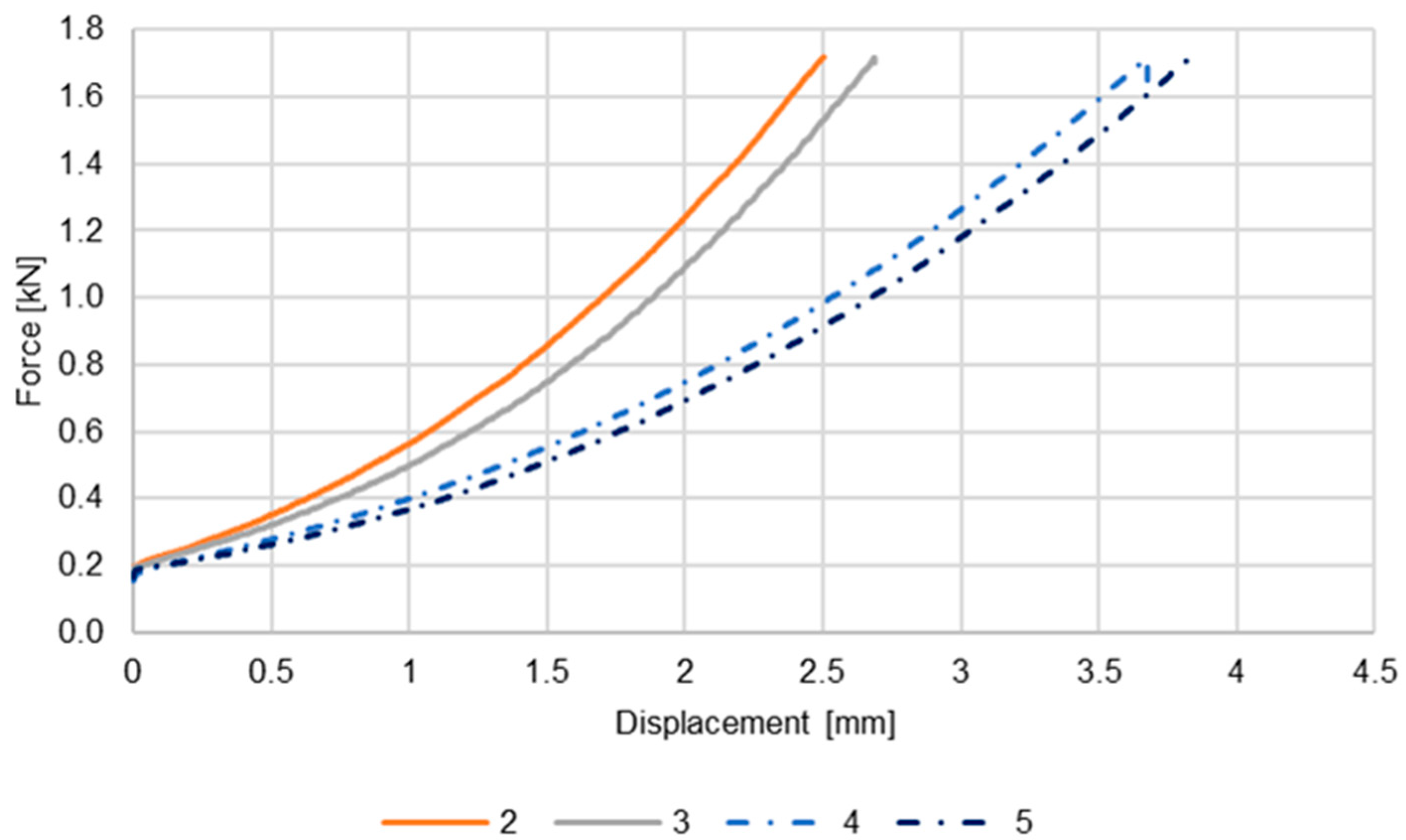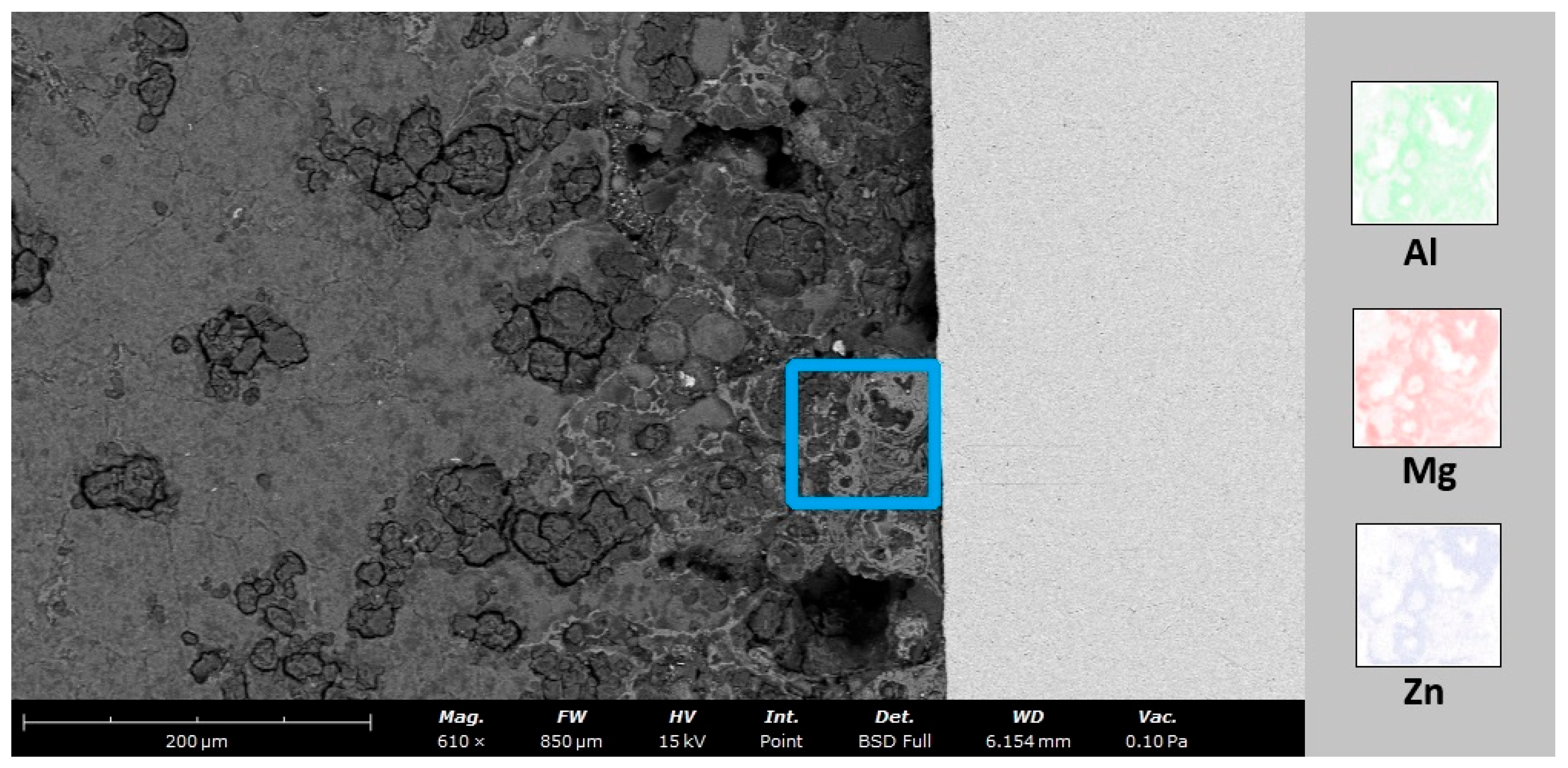On the Creation of a Material Bond between L-PBF-Manufactured AZ91 and Ti-6Al-4V Components in the Context of Medical Applications
Abstract
1. Introduction
1.1. Materials for Implant Applications
1.2. Titanium and Magnesium in L-PBF Processes
1.3. Material Composites Made of Titanium and Magnesium
2. Materials and Methods
2.1. Materials
2.2. Methods
2.2.1. Part Manufacturing
2.2.2. Joining Components and Testing of the Joint
- Temperature: 490 °C;
- Time: 3 h;
- Pressure: 100 MPa.
3. Results
3.1. Results of the Press-On Process
3.2. Results of the Push-Out Tests
3.3. Results of Metallographic Investigations
4. Discussion
5. Conclusions
Author Contributions
Funding
Institutional Review Board Statement
Informed Consent Statement
Data Availability Statement
Conflicts of Interest
References
- Tsakiris, V.; Tardei, C.; Clicinschi, F.M. Biodegradable Mg Alloys for Orthopedic Implants—A Review. J. Magnes. Alloys 2021, 9, 1884–1905. [Google Scholar] [CrossRef]
- Windhagen, H.; Radtke, K.; Weizbauer, A.; Diekmann, J.; Noll, Y.; Kreimeyer, U.; Schavan, R.; Stukenborg-Colsman, C.; Waizy, H. Biodegradable Magnesium-Based Screw Clinically Equivalent to Titanium Screw in Hallux Valgus Surgery: Short Term Results of the First Prospective, Randomized, Controlled Clinical Pilot Study. BioMed. Eng. OnLine 2013, 12, 62. [Google Scholar] [CrossRef] [PubMed]
- Ding, J.; Baumers, M.; Clark, E.A.; Wildman, R.D. The Economics of Additive Manufacturing: Towards a General Cost Model Including Process Failure. Int. J. Prod. Econ. 2021, 237, 108087. [Google Scholar] [CrossRef]
- Grün, N.G.; Donohue, N.; Holweg, P.; Weinberg, A.-M. Resorbierbare Implantate in der Unfallchirurgie. J. Miner. Stoffwechs. Muskuloskelet. Erkrank. 2018, 25, 82–89. [Google Scholar] [CrossRef]
- Aufa, A.N.; Hassan, M.Z.; Ismail, Z. Recent Advances in Ti-6Al-4V Additively Manufactured by Selective Laser Melting for Biomedical Implants: Prospect Development. J. Alloys Compd. 2022, 896, 163072. [Google Scholar] [CrossRef]
- Falkowska, A.; Seweryn, A.; Skrodzki, M. Strength Properties of a Porous Titanium Alloy Ti6Al4V with Diamond Structure Obtained by Laser Power Bed Fusion (LPBF). Materials 2020, 13, 5138. [Google Scholar] [CrossRef] [PubMed]
- Ataee, A.; Li, Y.; Brandt, M.; Wen, C. Ultrahigh-Strength Titanium Gyroid Scaffolds Manufactured by Selective Laser Melting (SLM) for Bone Implant Applications. Acta Mater. 2018, 158, 354–368. [Google Scholar] [CrossRef]
- Bartolomeu, F.; Costa, M.M.; Alves, N.; Miranda, G.; Silva, F.S. Selective Laser Melting of Ti6Al4V Sub-Millimetric Cellular Structures: Prediction of Dimensional Deviations and Mechanical Performance. J. Mech. Behav. Biomed. Mater. 2021, 113, 104123. [Google Scholar] [CrossRef]
- Elsayed, M.; Ghazy, M.; Youssef, Y.; Essa, K. Optimization of SLM Process Parameters for Ti6Al4V Medical Implants. RPJ 2019, 25, 433–447. [Google Scholar] [CrossRef]
- Alipal, J.; Mohd Pu’ad, N.A.S.; Nayan, N.H.M.; Sahari, N.; Abdullah, H.Z.; Idris, M.I.; Lee, T.C. An Updated Review on Surface Functionalisation of Titanium and Its Alloys for Implants Applications. Mater. Today Proc. 2021, 42, 270–282. [Google Scholar] [CrossRef]
- Sharma, A.; Oh, M.C.; Kim, J.-T.; Srivastava, A.K.; Ahn, B. Investigation of Electrochemical Corrosion Behavior of Additive Manufactured Ti–6Al–4V Alloy for Medical Implants in Different Electrolytes. J. Alloys Compd. 2020, 830, 154620. [Google Scholar] [CrossRef]
- Wu, C.L.; Zai, W.; Man, H.C. Additive Manufacturing of ZK60 Magnesium Alloy by Selective Laser Melting: Parameter Optimization, Microstructure and Biodegradability. Mater. Today Commun. 2021, 26, 101922. [Google Scholar] [CrossRef]
- Savalani, M.M.; Pizarro, J.M. Effect of Preheat and Layer Thickness on Selective Laser Melting (SLM) of Magnesium. Rapid Prototyp. J. 2016, 22, 115–122. [Google Scholar] [CrossRef]
- Ng, C.C.; Savalani, M.; Man, H.C. Fabrication of Magnesium Using Selective Laser Melting Technique. Rapid Prototyp. J. 2011, 17, 479–490. [Google Scholar] [CrossRef]
- Xie, K.; Wang, N.; Guo, Y.; Zhao, S.; Tan, J.; Wang, L.; Li, G.; Wu, J.; Yang, Y.; Xu, W.; et al. Additively Manufactured Biodegradable Porous Magnesium Implants for Elimination of Implant-Related Infections: An in Vitro and in Vivo Study. Bioact. Mater. 2022, 8, 140–152. [Google Scholar] [CrossRef]
- Matena, J.; Petersen, S.; Gieseke, M.; Teske, M.; Beyerbach, M.; Kampmann, A.; Escobar, H.; Gellrich, N.-C.; Haferkamp, H.; Nolte, I. Comparison of Selective Laser Melted Titanium and Magnesium Implants Coated with PCL. Int. J. Mol. Sci. 2015, 16, 13287–13301. [Google Scholar] [CrossRef]
- Vignesh, M.; Ranjith Kumar, G.; Sathishkumar, M.; Manikandan, M.; Rajyalakshmi, G.; Ramanujam, R.; Arivazhagan, N. Development of Biomedical Implants through Additive Manufacturing: A Review. J. Mater. Eng Perform 2021, 30, 4735–4744. [Google Scholar] [CrossRef]
- Kaushik, V.; Kumar, B.N.; Kumar, S.S.; Vignesh, M. Magnesium Role in Additive Manufacturing of Biomedical Implants—Challenges and Opportunities. Addit. Manuf. 2022, 55, 102802. [Google Scholar] [CrossRef]
- Manakari, V.; Parande, G.; Gupta, M. Selective Laser Melting of Magnesium and Magnesium Alloy Powders: A Review. Metals 2016, 7, 2. [Google Scholar] [CrossRef]
- Murray, J.L. The Mg−Ti (Magnesium-Titanium) System. Bull. Alloy Phase Diagr. 1986, 7, 245–248. [Google Scholar] [CrossRef]
- Baqer, Y.M.; Ramesh, S.; Yusof, F.; Manladan, S.M. Challenges and Advances in Laser Welding of Dissimilar Light Alloys: Al/Mg, Al/Ti, and Mg/Ti Alloys. Int. J. Adv. Manuf. Technol. 2018, 95, 4353–4369. [Google Scholar] [CrossRef]
- Mezbahul-Islam, M.; Mostafa, A.O.; Medraj, M. Essential Magnesium Alloys Binary Phase Diagrams and Their Thermochemical Data. J. Mater. 2014, 2014, 1–33. [Google Scholar] [CrossRef]
- Auwal, S.T.; Ramesh, S.; Tan, C.; Zhang, Z.; Zhao, X.; Manladan, S.M. Recent Developments and Challenges in Welding of Magnesium to Titanium Alloys. Adv. Mater. Res. 2019, 8, 47–73. [Google Scholar] [CrossRef]
- Siemers, C.; Bäker, M.; Brunke, F.; Wolter, D.; Sibum, H. Aluminum- and Vanadium-Free Titanium Alloys for Application in Medical Engineering. In Titanium in Medical and Dental Applications; Elsevier: Amsterdam, The Netherlands, 2018; pp. 477–492. ISBN 978-0-12-812456-7. [Google Scholar]
- Cooke, K.O.; Atieh, A.M. Current Trends in Dissimilar Diffusion Bonding of Titanium Alloys to Stainless Steels, Aluminium and Magnesium. J. Manuf. Mater. Process. 2020, 4, 39. [Google Scholar] [CrossRef]
- Tavoosi, M. The Kirkendall Void Formation in Al/Ti Interface during Solid-State Reactive Diffusion between Al and Ti. Surf. Interfaces 2017, 9, 196–200. [Google Scholar] [CrossRef]
- AlHazaa, A.; Alhoweml, I.; Shar, M.; Hezam, M.; Abdo, H.; AlBrithen, H. Transient Liquid Phase Bonding of Ti-6Al-4V and Mg-AZ31 Alloys Using Zn Coatings. Materials 2019, 12, 769. [Google Scholar] [CrossRef]
- Ohashi, O.; Kaieda, Y. Hot Isostatic Pressing of Diffusion Bonds in SUS 304 Stainless Steel. Weld. Int. 1990, 4, 35–41. [Google Scholar] [CrossRef]








| Material | Ti | Mg | Al | V | Fe | Zn | Mn |
|---|---|---|---|---|---|---|---|
| AZ91D | - | bal | 8.00 | - | 0.009 | 0.97 | 0.2 |
| Ti-6Al-4V | bal | - | 6.33 | 3.98 | 0.16 | - | - |
| Test Number | Maximum Force [kN] | Traverse Distance [mm] | Zinc Intermediate Layer [Yes/No] |
|---|---|---|---|
| 1 (Pre-Test) | to be determined | maximum | No |
| 2 | to be determined | 2.5 | No |
| 3 | 1.72 | to be determined | No |
| 4 | 1.72 | to be determined | Yes |
| 5 | 1.72 | to be determined | Yes |
Disclaimer/Publisher’s Note: The statements, opinions and data contained in all publications are solely those of the individual author(s) and contributor(s) and not of MDPI and/or the editor(s). MDPI and/or the editor(s) disclaim responsibility for any injury to people or property resulting from any ideas, methods, instructions or products referred to in the content. |
© 2024 by the authors. Licensee MDPI, Basel, Switzerland. This article is an open access article distributed under the terms and conditions of the Creative Commons Attribution (CC BY) license (https://creativecommons.org/licenses/by/4.0/).
Share and Cite
Grüger, L.; Jensch, F.; Dittrich, F.; Härtel, S. On the Creation of a Material Bond between L-PBF-Manufactured AZ91 and Ti-6Al-4V Components in the Context of Medical Applications. Materials 2024, 17, 4667. https://doi.org/10.3390/ma17184667
Grüger L, Jensch F, Dittrich F, Härtel S. On the Creation of a Material Bond between L-PBF-Manufactured AZ91 and Ti-6Al-4V Components in the Context of Medical Applications. Materials. 2024; 17(18):4667. https://doi.org/10.3390/ma17184667
Chicago/Turabian StyleGrüger, Lennart, Felix Jensch, Fabian Dittrich, and Sebastian Härtel. 2024. "On the Creation of a Material Bond between L-PBF-Manufactured AZ91 and Ti-6Al-4V Components in the Context of Medical Applications" Materials 17, no. 18: 4667. https://doi.org/10.3390/ma17184667
APA StyleGrüger, L., Jensch, F., Dittrich, F., & Härtel, S. (2024). On the Creation of a Material Bond between L-PBF-Manufactured AZ91 and Ti-6Al-4V Components in the Context of Medical Applications. Materials, 17(18), 4667. https://doi.org/10.3390/ma17184667







